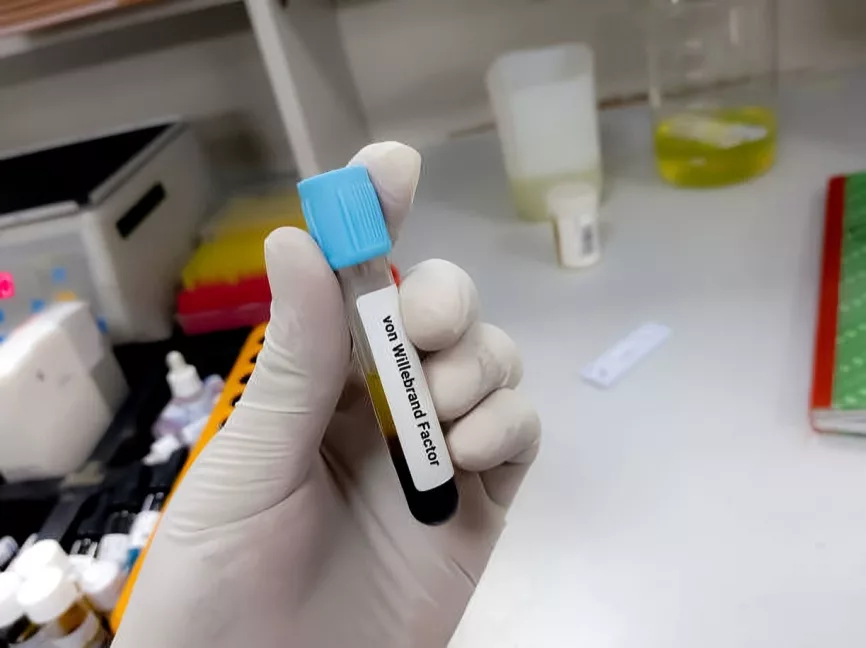Von Willebrand disease is one of the most prevalent blood disorders in the world.1Bowman M, Hopman WM, Rapson D, Lillicrap D, James P. The prevalence of symptomatic von Willebrand disease in primary care practice. J Thromb Haemost. 2010 Jan;8(1):213-6. doi: 10.1111/j.1538-7836.2009.03661.x. Epub 2009 Oct 23. PMID: 19874468. It affects the ability of your platelets to stick together and prolongs how much you bleed. Most cases aren’t serious, but severe disease can cause life-threatening complications.
What is Von Willebrand Disease?
Von Willebrand disease (VWD) is the most common inherited bleeding disorder, resulting from either a quantitative deficiency or qualitative defect in von Willebrand factor (VWF). VWF plays a crucial role in platelet adhesion to damaged blood vessels and stabilizing circulating factor VIII. Its deficiency or dysfunction impairs primary hemostasis and coagulation, leading to variable bleeding manifestations, ranging from mild mucocutaneous bleeding to severe hemorrhagic episodes.
It is named after Erik Adolf von Willebrand, a Finnish doctor who discovered it in 1926 while studying a Swedish family with unusual bleeding problems. The disease is the most common bleeding condition in the world, with 1% of the global population affected by it. Men and women are equally affected, though women may notice symptoms more during heavy menstruation each month.2CDC. (2024, May 22). Data and Statistics on von Willebrand Disease. Von Willebrand Disease (VWD). https://www.cdc.gov/von-willebrand/data/index.html
What Causes Von Willebrand Disease?
This disease happens if you don’t have enough von Willebrand factor (VWF) in your blood or if the factor you have in your blood doesn’t work the way it should. VWF is a protein that plays a key role in clotting. When you get injured, VWF helps platelets stick to the damaged blood vessel walls to form a clot and stop bleeding. It also carries and protects another important clotting protein, Factor VIII, which helps stabilize blood clots in your body.
When VWF is missing, defective, or not working properly, as in Von Willebrand Disease, your blood doesn’t clot as it should. These defects are hereditary and follow various patterns:
- Some types follow an autosomal dominant pattern — you only need one faulty gene from one parent to develop von Willebrand disease.
- More severe types follow an autosomal recessive pattern, which means that you must inherit defective genes from both parents to be affected.
- Some mutations cause your body to make less VWF than normal, leading to lower levels in your blood. Other mutations result in abnormal VWF that doesn’t work properly.3UpToDate. (2025). Uptodate.com. https://www.uptodate.com/contents/pathophysiology-of-von-willebrand-disease
Types of Von Willebrand Disease
This bleeding disorder is sorted into three main types based on how the VWF is affected. These include:
Type 1 Von Willebrand Disease:
This is the mildest type of VWD. It is also the most common, as it accounts for 50 to 75% of all cases. It results from a partial shortage of the von Willebrand factor, which still remains structurally and functionally intact. The disorder follows an autosomal dominant inheritance.
Type 2 Von Willebrand Disease:
Type 2 happens when your VWF gene has mutations that change how the von Willebrand factor works rather than how much of it is made. Depending on the exact defect, you could have one of four subtypes:
| Von Willebrand Disease Subtype | Characteristics |
| Type 2A | This subtype is caused by decreased platelet binding and abnormal VWF multimerization. It is the most common Type 2 subtype and follows an autosomal dominant inheritance pattern. |
| Type 2B | This subtype results from increased platelet binding due to a VWF mutation. It is less common and is inherited in an autosomal dominant manner. |
| Type 2M | This subtype occurs due to reduced VWF binding to platelets or collagen with normal VWF multimerization. It is rare and follows an autosomal dominant inheritance pattern. |
| Type 2N | Stands for “Normandy” and results from defective binding of VWF to factor VIII, leading to low factor VIII levels. This subtype mimics mild hemophilia A and is inherited in an autosomal recessive manner. Together, Type 2 subtypes make up 20-45% of all von Willebrand Disease cases worldwide. |
Type 3 Von Willebrand Disease:
Only 3% of individuals who have this bleeding disorder have type 3 of the disorder. Type 3 VWD follows an autosomal recessive inheritance pattern. The cause comes from mutations in the VWF gene, which means your body makes little to no functional VWF. It results in severe bleeding that can cause death.4Weyand, A. C., & Flood, V. H. (2021). Von Willebrand Disease. Hematology/Oncology Clinics of North America, 35(6), 1085–1101. https://doi.org/10.1016/j.hoc.2021.07.004
Signs & Symptoms
Since this bleeding disorder makes it hard for your blood to clot properly, it can lead to easy or prolonged bleeding, resulting in a clinical presentation that varies depending on the type of disease you have. Generally, the signs and symptoms include:

- Large, frequent bruises even from small bumps.
- Small red or purple spots called petechiae are caused by tiny blood vessels bleeding.
- Nosebleeds (Epistaxis) that occur often and take a long time to stop.
- Small wounds may keep bleeding longer than normal.
- Your gums may bleed easily, especially after brushing or flossing, or without any history of gum disease.
- Females may have very heavy or long menstrual bleeding. Menstrual blood may contain large clots, and you may need frequent pad changes.
- Women may also lose a lot of blood after giving birth.
- Excessive bleeding after medical procedures like tooth extractions and surgery.
- In severe cases, such as those of Type 3, bleeding can occur inside the body. You may bleed into joints or muscles and experience pain and swelling. Internal bleeding may cause red or dark-colored urine or stool.5Pollak, E. S. (2023, March 31). von Willebrand Disease Clinical Presentation: History, Physical Examination. Medscape.com; Medscape. https://emedicine.medscape.com/article/206996-clinical

How is a Von Willebrand Disease diagnosis established?
Diagnosis is usually done after a physical exam and a panel of lab tests.
History & Physical Exam:
Your medical team will ask about your medical history, menstrual history, and family history to see if anything raises the suspicion of a bleeding disorder. During the physical exam, your doctor will study your body for petechiae, unusual bruising, gum bleeding, and your general skin and joint health.
Laboratory Investigations:
A number of lab tests are performed to arrive at the diagnosis of von Willebrand disease, as well as to determine its severity.
- Activated partial Thromboplastin Time, or aPTT, calculates how long it takes for your blood to clot and may be prolonged if Factor VIII levels are low.
- Prothrombin Time (PT) checks the clotting ability of other factors in your body, but is usually normal in von Willebrand disease.
- A Complete Blood Count assesses overall blood health and may show signs of anemia due to excessive bleeding. It also tells if your excessive bleeding is because of having a low number of platelets instead of von Willebrand disease.
- A Bleeding Time test evaluates how long small blood vessels take to stop bleeding, though it is less commonly used now.
- Platelet Function tests analyze how well your platelets work in blood clotting.
- Von Willebrand Factor Antigen test (VWF: Ag) checks the amount of von Willebrand factor in your blood.6Ingerslev J. A sensitive ELISA for von Willebrand factor (vWf:Ag). Scand J Clin Lab Invest. 1987 Apr;47(2):143-9. PMID: 3107116.
- Ristocetin Cofactor Activity (VWF: RCo) evaluates how well the von Willebrand factor helps your platelets stick together.
- The Factor VIII Activity test checks the level of Factor VIII in your body.
- The Multimer Analysis test examines the size and structure of the von Willebrand factor to identify subtypes.
- Ristocetin-Induced Platelet Aggregation or RIPA detects abnormal platelet clumping, especially in Type 2 B.

Imaging:
Imaging is not typically used to diagnose von Willebrand disease. However, in certain cases, like severe Type 3 von Willebrand disease, it may be helpful to assess for the complications of internal bleeding or to rule out other conditions. Modalities such as ultrasound, CT scan, and MRI scan are used for this purpose.7Ayan Sabih, & Babiker, H. M. (2023, August 28). Von Willebrand Disease. Nih.gov; StatPearls Publishing. https://www.ncbi.nlm.nih.gov/books/NBK459222/
Complications
While mild cases of this bleeding disorder only lead to occasional issues, severe forms can result in life-threatening complications:
- About 10–15% of people with a type 3 von Willebrand diagnosis develop antibodies against VWF replacement therapy. This can cause serious allergic reactions, including life-threatening anaphylaxis, during treatment. It can also make you become treatment-resistant.
- Bleeding may not always occur immediately after injury or surgery, but can start hours or even days later. This can occur after minor injuries or surgical procedures.
- Severe blood loss from injuries, internal bleeding, or childbirth can lead to shock.8Lavin M, Aguila S, Dalton N, Nolan M, Byrne M, Ryan K, White B, O’Connell NM, O’Sullivan JM, Di Paola J, James PD, O’Donnell JS. Significant gynecological bleeding in women with low von Willebrand factor levels. Blood Adv. 2018 Jul 24;2(14):1784-1791. doi: 10.1182/bloodadvances.2018017418. PMID: 30042144; PMCID: PMC6058240.
- Gastrointestinal bleeding can be chronic and lead to anemia or acute blood loss, which requires emergency care.
- Brain hemorrhage is a rare but serious complication. It can cause paralysis, coma, or death.
- Persistent bleeding in joints can cause joint degeneration and joint death.9Von Willebrand disease: MedlinePlus Genetics. (2021). Medlineplus.gov. https://medlineplus.gov/genetics/condition/von-willebrand-disease/
Treatment of Von Willebrand Disease
There is no permanent cure for Von Willebrand disease, but with the right management plan and lifestyle adjustments, you can lead a healthy life with it. The treatments usually include:
Increasing VWF Levels:
Therapies that increase VWF levels don’t directly treat von Willebrand disease, but they can be useful in managing symptoms related to low VWF levels.
| Method | How It Works | Who It’s For | Administration |
| Desmopressin or DDAVP | Stimulates the release of stored VWF and factor VIII | Type 1 and some Type 2 | Intravenous, Subcutaneous, Nasal Spray |
| Oral Contraceptives | Estrogen increases VWF levels and reduces menstrual bleeding | Women, especially those with heavy periods | Oral via birth control pills |
| Hormonal IUDs | Releases hormones that reduce menstrual bleeding and may help with VWF levels | Women, especially those with heavy periods | Intrauterine |
Replacing Missing VWF:
Unlike milder cases that may respond to medications, some patients simply do not produce enough VWF, or they may produce too many dysfunctional forms of the factor. In these situations, direct VWF replacement is necessary.
VWF replacement therapy provides both VWF and factor VIII and is used for these severe cases or if you are unresponsive to desmopressin. Plasma-derived or recombinant VWF concentrates, as well as individual Factor VIII/VWF concentrates, are administered intravenously for this purpose. This is done for bleeding episodes and surgeries.
Preventing Clot Breakdown:
Even if your vWF levels increase or get replaced, your body may still break down clots too fast. This can lead to ongoing bleeding despite treatment. To stop this, your doctor may prescribe antifibrinolytic medications, e.g., tranexamic acid and aminocaproic acid, which block the enzymes that dissolve blood clots. You may take these medications by mouth or through an IV infusion.
Controlling Bleeding:
Your doctor may recommend additional treatments to control bleeding directly at the site. Fibrin sealants, a type of medical glue, can be applied to wounds to stop bleeding quickly. Nasal sprays with desmopressin are also used during nosebleed emergencies.
Lifestyle Modifications :
If you have von Willebrand disease, your daily habits make a big difference in preventing excessive bleeding, such as:
- Avoid high-impact sports like football or boxing that increase the risk of injury. Opt for low-impact exercise like swimming, walking, or cycling instead.
- Always check with your doctor before taking new medications, as a number of them can affect your bleeding time, clotting time, and platelet function, such as:
- Aspirin
- Ibuprofen
- Naproxen
- Warfarin
- Clopidogrel
- Heparin
- Rivaroxaban
- Apixaban
- Edoxaban
- Track your menstrual cycle to monitor heavy bleeding. Your doctor can recommend treatments to make periods more manageable.
- Brush and floss to prevent dental issues, as sound dental hygiene can reduce the need for invasive dental procedures that can cause bleeding. Be careful and avoid hurting yourself to prevent bleeding.
- Take special care to prevent injuries at home. Use protective gear for activities with fall risks, keep sharp objects safely stored, and take care when shaving or handling tools.
- Alcohol can interfere with platelet function and increase bleeding, so it’s advisable to limit or avoid alcohol altogether.
- Some over-the-counter medications and herbal supplements can interfere with blood clotting. Always check with your healthcare provider before taking anything new.
- Work with a hematologist and obstetrician experienced in high-risk pregnancies to create a safe birth plan.10Connell, N. T., Flood, V. H., Romina Brignardello-Petersen, Rezan Abdul-Kadir, Arapshian, A., Couper, S., Grow, J. M., Kouides, P., Laffan, M., Lavin, M., Frank, O’Brien, S. H., Ozelo, M. C., Tosetto, A., Weyand, A. C., James, P. D., Kalot, M. A., Nedaa Husainat, & Mustafa, R. A. (2021). ASH ISTH NHF WFH 2021 guidelines on the management of von Willebrand disease. Blood Advances, 5(1), 301–325. https://doi.org/10.1182/bloodadvances.2020003264
Side Effects of Von Willebrand Disease Medication
While medications are essential for managing von Willebrand disease, they come with potential side effects that must be closely monitored, such as:
- Desmopressin use, especially with multiple doses and fluid intake, can lead to dangerously low sodium levels.
- Desmopressin and antifibrinolytic agents increase the risk of clot formation, which can be problematic in patients with cardiovascular or cerebrovascular conditions.
- Tranexamic acid is not recommended for patients with gross hematuria as it may cause clot formation, leading to ureteric or urethral obstruction.
In addition, these drugs can also have general side effects like headache, nausea, dizziness, vomiting, and sleep disturbances.11Sabih, A., & Babiker, H. M. (2020). Von Willebrand Disease. PubMed; StatPearls Publishing. https://www.ncbi.nlm.nih.gov/books/NBK459222/
Conclusion
This bleeding disorder is a hereditary condition that affects the clotting ability of your blood. Suspicion is sparked by excessive, abnormal bleeding without a cause. Diagnosis typically involves a clinical exam and blood tests. Treatment focuses on managing bleeding episodes and preventing complications.
Refrences
- 1Bowman M, Hopman WM, Rapson D, Lillicrap D, James P. The prevalence of symptomatic von Willebrand disease in primary care practice. J Thromb Haemost. 2010 Jan;8(1):213-6. doi: 10.1111/j.1538-7836.2009.03661.x. Epub 2009 Oct 23. PMID: 19874468.
- 2CDC. (2024, May 22). Data and Statistics on von Willebrand Disease. Von Willebrand Disease (VWD). https://www.cdc.gov/von-willebrand/data/index.html
- 3UpToDate. (2025). Uptodate.com. https://www.uptodate.com/contents/pathophysiology-of-von-willebrand-disease
- 4Weyand, A. C., & Flood, V. H. (2021). Von Willebrand Disease. Hematology/Oncology Clinics of North America, 35(6), 1085–1101. https://doi.org/10.1016/j.hoc.2021.07.004
- 5Pollak, E. S. (2023, March 31). von Willebrand Disease Clinical Presentation: History, Physical Examination. Medscape.com; Medscape. https://emedicine.medscape.com/article/206996-clinical
- 6Ingerslev J. A sensitive ELISA for von Willebrand factor (vWf:Ag). Scand J Clin Lab Invest. 1987 Apr;47(2):143-9. PMID: 3107116.
- 7Ayan Sabih, & Babiker, H. M. (2023, August 28). Von Willebrand Disease. Nih.gov; StatPearls Publishing. https://www.ncbi.nlm.nih.gov/books/NBK459222/
- 8Lavin M, Aguila S, Dalton N, Nolan M, Byrne M, Ryan K, White B, O’Connell NM, O’Sullivan JM, Di Paola J, James PD, O’Donnell JS. Significant gynecological bleeding in women with low von Willebrand factor levels. Blood Adv. 2018 Jul 24;2(14):1784-1791. doi: 10.1182/bloodadvances.2018017418. PMID: 30042144; PMCID: PMC6058240.
- 9Von Willebrand disease: MedlinePlus Genetics. (2021). Medlineplus.gov. https://medlineplus.gov/genetics/condition/von-willebrand-disease/
- 10Connell, N. T., Flood, V. H., Romina Brignardello-Petersen, Rezan Abdul-Kadir, Arapshian, A., Couper, S., Grow, J. M., Kouides, P., Laffan, M., Lavin, M., Frank, O’Brien, S. H., Ozelo, M. C., Tosetto, A., Weyand, A. C., James, P. D., Kalot, M. A., Nedaa Husainat, & Mustafa, R. A. (2021). ASH ISTH NHF WFH 2021 guidelines on the management of von Willebrand disease. Blood Advances, 5(1), 301–325. https://doi.org/10.1182/bloodadvances.2020003264
- 11Sabih, A., & Babiker, H. M. (2020). Von Willebrand Disease. PubMed; StatPearls Publishing. https://www.ncbi.nlm.nih.gov/books/NBK459222/





